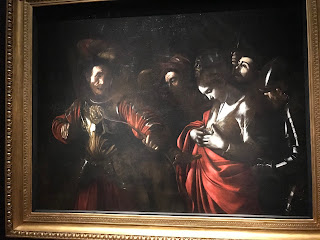Two weeks ago, we parked our car in Newport and took a train and tube to the National Gallery to see the Caravaggio Exhibition. Because my wife is a member of the National Gallery we were able to enjoy a members only preview of the Exhibition—all two pictures of it: Head of John the Baptist and the newly discovered/attributed The Martyrdom of St Ursula. Being a grasping, hard-hearted soul, my first impression was ‘Just two pictures? We’ve paid carpark charges, train fares and the cost of a Tube ticket.’ Fortunately that first impression didn’t last very long.
We entered a dark room which heightened the effect of the two illuminated paintings. Because access was limited to members, there were relatively few there and you could press your nose to the picture, if you were weird. Not being that weird I took two photos (but no selfie) and two more to be sure. Then, I thought, I’d better get my money’s worth. (I’m a philistine. My wife’s the art lover.)
I studied first one picture and began noticing things. I studied the other. And this is the beauty of being limited to just two paintings as opposed to wandering around amidst hundreds, seeing and not seeing, like a goldfish or butterfly.
Okay, so I’ve seen each picture twice. Was that it? Why were my wife and friend spending ages before each painting, and then returning time and again? FOMO struck, forcing me to follow their example.
I read the explanatory blurb more closely:
‘This almost monochromatic composition shows Caravaggio’s ability to reduce a story to its essentials. We are confronted with the horror of the severed head, the brutish power of the executioner, the old woman’s sorrow, and the complex revulsion of Salome who, at her mother’s bidding, had requested St John’s head on a platter.’
I saw all this and more, in particular the incredible brushwork on St John’s hair, and face, especially around the lips, as well as his use of light for dramatic effect.
The Martyrdom of St Ursula
The painting and subject were commissioned by Caravaggio’s patron Marcantonio Doria, whose stepdaughter was about to become a nun using the name ‘Sister Ursula.’ Inspiration or warning perhaps. Who knows? The Martyrdom of St Ursula, Caravaggio’s last documented painting, depicts a scene from the legend of a Christian princess whose 11,000 virgin followers were massacred in Cologne by the Huns. Struck by her beauty, the Hun leader promised to spare her in exchange for ‘marriage’ which may be a euphemism.
Whilst other artists may have painted a grand tableau maximising the 11000 virgins, Caravaggio focused on a small, dark, intimate space and somehow draws you into the drama as one of the spectators. The blurb highlights the importance of the hands, the guilty hand of the murderer, the outstretched hand of the bystander unable to stop the arrow, and Ursula’s hands framing the wound. Caravaggio paints himself in the picture--- the startled, open-mouthed soldier looking over Ursula’s shoulder.
Little did he know he’d be dead, just a few weeks after finishing the painting.
Two near contemporary biographies, one by Giovanni Baglione (1556- 1643)
the other by Giovanni Pietro Bellori (1613-1696) Both tell the same graphic story of his death.
The story of Caravaggio is well known, the bad boy of art who murdered a rival and fled Rome to be feted, despite the charge hanging over him, as one the foremost painters of his day. What’s startling is that apart from a very brief apprenticeship to a fresco painter, he had no formal training whatever and was entirely self-taught.
His final months were dominated by tragedy. Caught in a tavern brawl he was hideously scarred on the face before being tossed between hope and despair. Believing he’d been pardoned by the Pope, he sailed back to Rome with his paintings and possessions. On landing he was mistakenly arrested and separated from his possessions, the boat sailing on without him. On being freed, the desperate Caravaggio rushed after the boat in the heat of an Italian summer and was struck down by a raging fever. While enthusiastic crowds waited for him in Rome, he died miserable and alone on a deserted Italian beach.
I realised again how lucky I was to enjoy what was an intimate preview after reading this account in London’s Evening Standard. Well worth reading, especially for the tributes from cinema greats like Martin Scorsese.






No comments:
Post a Comment